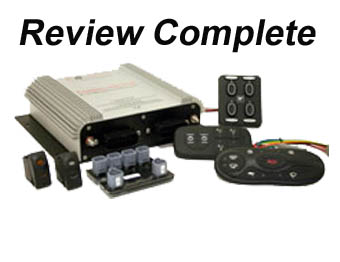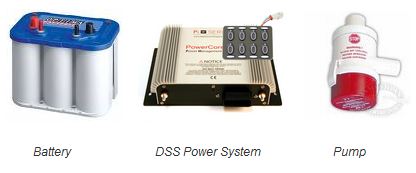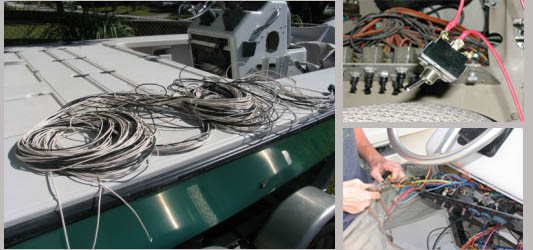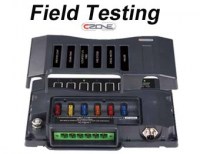
Marine Switching
Rating: Not Rated YetQuick overview
- Digital marine switching.
- Resettable solid state breaker- no fuses
- Programmable marine switching
- Simplify circuits .
Whether you’ve got a 20 foot flats boat, or a 36 foot offshore setup, you most likely have a network of wires, fuses, switches and connections making up your marine electrical system, and keeping that boat moving begins with keeping the electrical system healthy. In many cases, the first thing to fail in the electrical system is the connection points, followed closely by the switches. If you’ve ever inspected your electrical system I’m sure you’ve seen spliced wires, connectors, split wiring harnesses, fuse panels, and multi grounding / hot terminals. Each time a wire is spliced it acts as an open wound, begging for corrosion to set in like the infection that it is. Each new connection to a terminal opens the door for more infections. By the time a boat gets a few years on it and changes hands a few times, the amount of substandard and jury-rigged wiring on it can add up to a substantial number of faults.
Unfortunately, it isn’t as easy as spraying on some antiseptic and calling it a day. Other connections such as your grounding /hot terminals may be made of quality metal, however, as the years pass and new wires are added, various metals are introduced via the wire connectors and the process of corrosion begins. The majority of people do not understand the aspects of introducing different metal together and the consequences that arise from doing so. The old adage that opposites attract holds true here as well, but what’s being attracted will not end in a romantic memory.
There’s another old saying that goes, “an ounce of prevention is worth more than a pound of cure.” Well that may be a snazzy saying and true for any boat that hasn’t been in the water, but let’s face the realism in the marine world, if your boat is more than a few months old or has seen the salt water a few times, not only do you need a preventive measure in place, but you’ll soon need the cure! It doesn’t come in a can, and certainly can’t be disinfected or bandaged. Corrosion creeps up on you like cholesterol; unknowingly until something fails.
I’ve been an avid boater and angler for many years and have sprayed enough gunk on terminals to fill an Olympic size swimming pool, yet still continued to think that I’d one day find the cure through liquid magic. Don’t get me wrong, as there are some very good products on the market that do help cut back on corrosion, but have they reached the statuesque of a cure? Hardly! They are a preventive measure, and even then their effectiveness is in question.
So where does one start in the battle to end corrosion? Rather than trying to band aid the occurrence of corrosion with sprays, gels and other methods, starting with a good electrical system should be of the highest priority. A good electrical system starts by having the least amount of connection points and exposed points that allow corrosion attacks, along with quality sealed connections on those points.
How many times have you replaced a blown fuse on a fishing trip, spent an hour or more trying to figure out why your jack plate or running lights aren’t working, or noticed your gauges and lights flicker when your boat pounds against a wave?
Let’s look at the typical components in a simple bait well circuit.

That’s 8 connection points that will most certainly become a problem down the road. Out of those 8 connections, 6 are open air connections, as the two for the pump will most likely be sealed in some fashion, and those two that are sealed are usually sealed improperly which will eventually follow suit.
Wouldn’t it be nice to cut out a few of these connections and have a solid line of contact with fewer connections? Of course it would, which brings me to the backbone of this review. Before we get into the nuts and bolts, let’s look at the same set-up using the DSS system.

To run this set up we only need 2 connections, a hot and ground coming from the sealed power center to the pump. That’s it! We now have eliminated 6 connections, a ton of wiring and lots of time. Now I know there may be some of you reading this and not agreeing with excluding a few connections, so if we were to add in all points from the power center forward it would be a connection to the keypad (1) and (2&3) to the pump. Any way you look at it we’ve either cut 5 or 6 connections out.
By now you should start to see where the value of this system begins, and what it can do for you just through one application. To go a bit further, let’s add another 5 similar components and eliminate 6 connections from each. Overall you’ve cut 36 connections from your system! If that were the end of the story it would surely peak my interest, but there is more!
I suppose you may be wondering what happened to the fuses and terminal blocks at this point? In short, they’ve been replaced by high quality solid state circuit breakers with over current protection sealed inside the power center. The load controller is accomplished by using current-sensing power MOSFETs for each output. The output current sensed by the MOSFET is then read in by a microcontroller and compared to the trip current programmed for that circuit. If it is greater than the programmed value, the circuit is shut off and the corresponding LED on the keypad flashes to indicate a circuit fault to the user. Should the circuit trip, the user simply holds down the flashing key on the dash keypad for 8 seconds and the system resets. Had you been using a traditional fuse block setup you’d be forced to find a fuse, locate the block and replace the fuse, and in some boats this is easier said than done.
There is no doubt that by eliminating wires, connectors, and unnecessary switches, you ultimately increase the reliability of your vessel in more ways than just your electrical system. As noted throughout the sidebars, electrical leaks are the catalyst of many corrosion problems and are very common in the marine world, as elements such as salt, water, humidity, oil, fuel and many others lend a helping hand to corrosion, and by introducing an electrical field into the mix it becomes magnified, sort of like breeding bacteria.
These problems are usually in the form of component and wire failures due to shorts, excessive resistance in the wires that takes its toll on lights and motors, and the dreaded corrosion of interior and exterior metals such as outdrives, props, trim tabs, zinc, hose clamps, plumbing, etc.
With that being said, we know that any improvement you do to your wiring will be a benefit to your vessels overall health and longevity. The DSS system is just that, an improvement to overall health and longevity, and once it is installed and running you’ll be virtually maintenance free. No more wondering why your running lights worked the previous day and not the following. We’ve all been there. You plan for a nice day of boating, load your gear, fire up the motor and realize that your bilge and running lights are out. The next few hours are dedicated to fixing the problem rather than enjoying the day.
Designed to be a full featured controller, the DSS is capable of controlling all of your switching needs in a single sealed housing that is durable, light weight and easy to install. The system is fully programmable to meet your requirements, and it can even automate functions such as time on / time off, reverse polarity, etc., but most of this programming must be done by the company at this time.
However, as of late 2009, DSS is making some changes in the 210 and 21 series that will allow the end user to customize the output voltage whenever needed. This allows you to add new components and adjust your output to match the amp draw.
Unfortunately, as I write this in November of 2009, DSS does not offer the 210 system to the general public, but is gearing up to do so through third party integrators, of which Florida Inshore Angler.com will be a source for Florida. After testing this product for 3 years I cannot say enough about it, thus the reasoning for venturing into the third party integration.
MY EXPIERENCE & CONCLUSION:
 I’ve been using this system for over 3 years (as of March 2011) and have yet to see a single problem or even a blip in the systems performance. When the system first arrived it looked a bit overwhelming with the two massive bundles of wire, an amplifier looking unit and multiple keypads with various configurations. After unraveling the coiled wire I realized that they provided excessive lengths of wire so as not to come up short.
I’ve been using this system for over 3 years (as of March 2011) and have yet to see a single problem or even a blip in the systems performance. When the system first arrived it looked a bit overwhelming with the two massive bundles of wire, an amplifier looking unit and multiple keypads with various configurations. After unraveling the coiled wire I realized that they provided excessive lengths of wire so as not to come up short.
It wasn’t long before I dove in and started ripping out wires and switches galore. You don’t realize how much wiring is involved in a traditional system until you really get in there and pull them out.
This was just the beginning to a network of wires. Rather than choosing to leave the factory wire in, which would be the jury-rigged way, I removed all of the original wiring installed by Hewes. I must give a special thanks to the guys at Hewes for putting in high quality wire and accessories, as everything in this 1993 boat was in great shape, which made me wonder why I was tearing apart a perfectly conditioned wiring system. Needless to say, I felt I was putting something better in, and soon would learn that I did.
The install was straight forward as it relates to the DSS system, but pulling wire to various components was a bit of a challenge! Using the provided wire tags made it easy to tag each wire and complete the hook up to the component with no confusion. I ensured that each connection from the DSS to the component was braided, soldered and fitted with high quality epoxy heat shrink. The power center was securely mounted inside the console and all wires were routed, tied and wrapped as shown to the left.
I have done absolutely no maintenance to the wiring system or the power center since the install and have not seen any corrosion on the unit or to the wiring. Also worth noting is that DSS uses all marine grade tinned wire. This is truly a great system and should be standard on all boats.
UPDATE: I have yet to see a single problem year after year. This is very rare to find in a marine product, especially in the electrical system. This system has served me well over the past 4 years, and as it looks at this point, I don't foresee any near future problems. After inspecting the system closely today, everything from the wires to the unit remains in new condition 4 years later. I tested the wire resistance from the main harness of the unit to several components and it's showing no signs of wire deterioration via voltage drops or increases in resistance. In short, no corrosion or signs of trouble. I'll have another look in a few years, but for now, I can say that I'm 100% good to go on my electrical system and highly recommend this system.
INFO
Digital Marine Switching Review
REVIEWER CREDENTIALS
Allen Applegarth is a published author and outdoor writer. He's an avid boater and angler with over 30 years of experience in the marine industry. He is also a product designer / fabricator and experienced electronics tech, with a few medical devices designed and implemented under his accomplishments . He owns and operates a communications and IT company providing service to many industries, from cellular tower and satellite transmission, hospital and sports arena DAS systems, and large scale commercial networks, to RFID, CCTV, Fiber optic, automation and more. Whether it be a high-tech power load controller center, an automated series of motors and actuators, or a simple fishing rod guide, Allen's broad range of skills enables him to test products with accuracy and provide valuable insight to help consumers make informed decisions.


 BEP CZone Switching -- Progress = 2%
BEP CZone Switching -- Progress = 2%